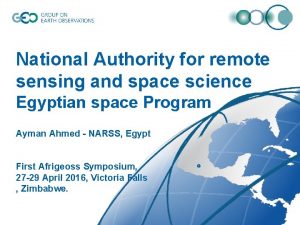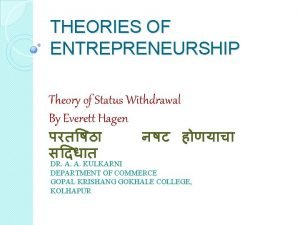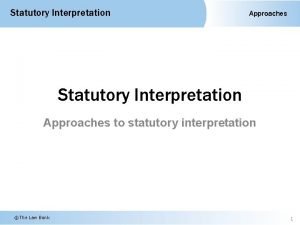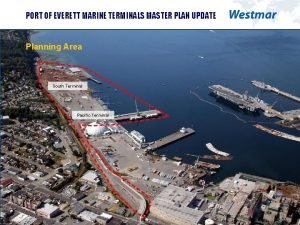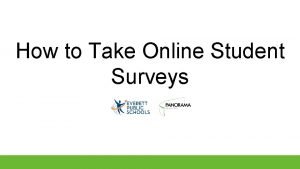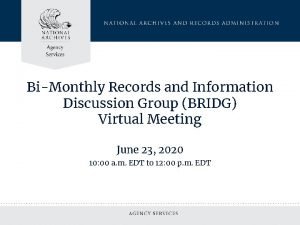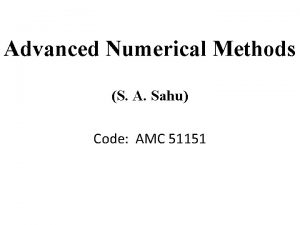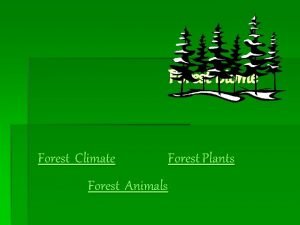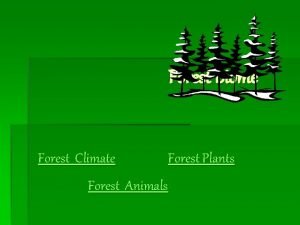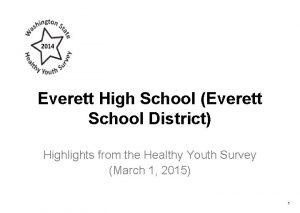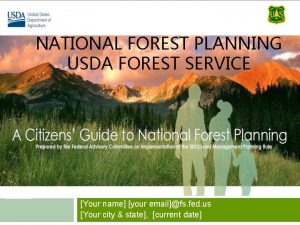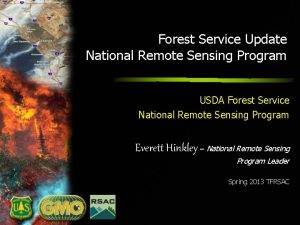Forest Service Fall 2019 Everett Hinkley National Remote









- Slides: 9

Forest Service – Fall 2019 Everett Hinkley National Remote Sensing Program Manager Everett. hinkley@usda. gov Fall TFRSAC Meeting November 14, 2019

Components of the Geospatial Management Office • Geospatial Information Officer • • • Deb Oakeson – Acting GIO Headquarters Program Leads • Remote Sensing- Everett Hinkley • Geospatial Products & Services - Betsy Kanalley • GIS- Lisa Mc. Bride • Data Management - Lisa Delmonico Geospatial Technology& Applications Center • Deb Oakeson – Center Director • Brian Vanderbilt – Ass’t Director, Geospatial and Remote Sensing Services • Melissa Hamid – Ass’t Director of Data, Technology and User Services

GMO Stakeholder Relationships – As Is 9/20/19 Mobile Geospatial Tech Advisory Group (MGTAG) Fire and Aviation Management (FAM) Office of Tribal Relations RIM Ecosystem Management Coordination (EMC) Mapping Strategy Team (MST) Business Operations (Bus. Ops) Strategic Plng, Budget, and Accountability (SPBA) Forest Inventory and Analysis (FIA) Geospatial Technology Apps Steering Com (Geo. TASC) RIM Inventory, Monitoring, and Assessment (IMA) Automated Lands Program (ALP) RIM Chief Information Office (CIO) Geospatial Services Branch Enterprise Data Warehouse (EDW) Enterprise Business Solutions Svcs (EBSS) Natural Resource Manager (NRM) Forest Health Assessment and Applied Sciences Team (FHAAST) Legislative Affairs Lands Information Management Advisory Board (IMAB) Geospatial Management Advisory Group (GMAG) Research and Development (R&D) Office of Sustainability and Climate Engineering (ETG) National Technology Development Program (NTDP) RIM Forest Health Protection National Forest System (NFS) Recreation (RHVR) State and Private Forestry (S&PF) Information Resources Decision Board (IRDB) CAs Information Resource Management (IRM) Pacific NW Research Station (PNW) Enterprise Business Solutions Svcs (EBSS) Chief’s Office Pacific SW Research Station (PSW) WWETAC Law Enforcement and Inv. (LEI) Rocky Mtn Research Station (RMRS) IMD Office of Communication Geospatial Management Office (GMO) International Programs Northern Research Station (NRS) EWETAC IMD GIS, RS, Geo. Svcs Southern Research Station (SRS) GIS IMD Engineering RS, Geo. Svcs GIS, RS, Geo. Svcs IMD Region 1 GIS, RS, Geo. Svcs Engineering Region 2 Mix of operations/tactical and strategic Governance External – Mix of ops/tac and strategic Line authority GIS Geo. Svcs GIS, RS, Geo. Svcs RS Lab IMD Region 3 Region 10 IMD USDA and USDA Agencies Region 9 (Includes Former NE Area) IMD IMD Stakeholder Relationships Predominantly strategic GIS, RS, Geo. Svcs DOI and DOI Bureaus NASA Region 8 Region 4 Region 5 Region 6 Others NOAA DOD Academia

Strategic Focus Areas • • • Support to Wildland Fire Land use planning and resources management GPS and Mobile technologies Unmanned Aircraft Systems Integration of remote sensing, GIS, and cartography in the USFS Mapping standards Map production and usability improvements Data lifecycle management Enterprise Architecture (Geospatial) Training Web-based and other interactive maps Digital map product distribution and delivery

Questions

Challenges / Opportunities • Across our agency, a general lack of understanding of the value of remote sensing and geospatial data in a land management agency. • Aging sensors, platforms, etc. • Inability to travel and attend conferences. Face-to-face is clearly preferred for idea exchanges. • Enterprise architecture does not support remote sensing needs fully. • Managing access to classified data for applications to support agency business needs

Challenges / Opportunities • Working with declining budgets and work force – Downward spiral in funding having significant impacts on testing and deploying current and emerging technologies. • Integrating UAS into remote sensing business needs • Working more collaboratively with the USDA department and other government agencies • Adapting to and incorporating new remote sensing data streams • Data center movement (disruption and cost issues) • Scanning hard copy aerial film at SLC facility (FSA)

Questions Current Improve • What do we need to continue or keep? • What’s working and adding value? • What are our best practices? • What do we need to do to improve? • What’s working satisfactorily, but needs improvement or refinement? • What do we need to modify? Current State Analysis Stop Start • What do we need to stop doing? • What are we doing that is not adding value? • What can we omit? • What do we need to start doing? • What new approach could we use? • What do we need to add?

Contact Us Geospatial Management Office Everett Hinkley National Remote Sensing Prog. Mgr. USDA Forest Service HQ Sidney R. Yates Federal Building 201 14 th St SW, Washington, DC 20227 Voice: 703. 605. 0830 Email: everett. hinkley@usda. gov
 Erin brockovich movie kurt potter
Erin brockovich movie kurt potter National authority for remote sensing and space sciences
National authority for remote sensing and space sciences Status of withdrawal is associated with which theory
Status of withdrawal is associated with which theory Purposive rule of interpretation
Purposive rule of interpretation Pinner v everett
Pinner v everett Everett marine terminal
Everett marine terminal Surveys.panoramaed.com/everett
Surveys.panoramaed.com/everett Father of music therapy
Father of music therapy Nara bridg
Nara bridg Gauss forward interpolation formula is used for
Gauss forward interpolation formula is used for

